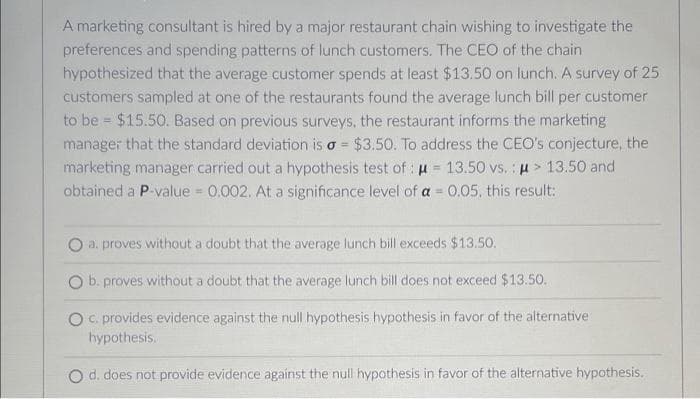A marketing consultant is hired by a major restaurant chain wishing to investigate the preferences and spending patterns of lunch customers. The CEO of the chain hypothesized that the average customer spends at least $13.50 on lunch. A survey of 25 customers sampled at one of the restaurants found the average lunch bill per customer to be $15.50. Based on previous surveys, the restaurant informs the marketing manager that the standard deviation is a $3.50. To address the CEO's conjecture, the marketing manager carried out a hypothesis test of μ = 13.50 vs.: u 13.50 and obtained a P-value = 0.002. At a significance level of a = 0.05, this result: a. proves without a doubt that the average lunch bill exceeds $13.50. O b. proves without a doubt that the average lunch bill does not exceed $13.50. O c. provides evidence against the null hypothesis hypothesis in favor of the alternative. hypothesis. O d. does not provide evidence against the null hypothesis in favor of the alternative hypothesis.
A marketing consultant is hired by a major restaurant chain wishing to investigate the preferences and spending patterns of lunch customers. The CEO of the chain hypothesized that the average customer spends at least $13.50 on lunch. A survey of 25 customers sampled at one of the restaurants found the average lunch bill per customer to be $15.50. Based on previous surveys, the restaurant informs the marketing manager that the standard deviation is a $3.50. To address the CEO's conjecture, the marketing manager carried out a hypothesis test of μ = 13.50 vs.: u 13.50 and obtained a P-value = 0.002. At a significance level of a = 0.05, this result: a. proves without a doubt that the average lunch bill exceeds $13.50. O b. proves without a doubt that the average lunch bill does not exceed $13.50. O c. provides evidence against the null hypothesis hypothesis in favor of the alternative. hypothesis. O d. does not provide evidence against the null hypothesis in favor of the alternative hypothesis.
Glencoe Algebra 1, Student Edition, 9780079039897, 0079039898, 2018
18th Edition
ISBN:9780079039897
Author:Carter
Publisher:Carter
Chapter10: Statistics
Section10.4: Distributions Of Data
Problem 19PFA
Related questions
Question

Transcribed Image Text:A marketing consultant is hired by a major restaurant chain wishing to investigate the
preferences and spending patterns of lunch customers. The CEO of the chain
hypothesized that the average customer spends at least $13.50 on lunch. A survey of 25
customers sampled at one of the restaurants found the average lunch bill per customer
to be $15.50. Based on previous surveys, the restaurant informs the marketing
manager that the standard deviation is a = $3.50. To address the CEO's conjecture, the
marketing manager carried out a hypothesis test of: μ = 13.50 vs.: μ> 13.50 and
obtained a P-value = 0.002. At a significance level of a = 0.05, this result:
a, proves without a doubt that the average lunch bill exceeds $13.50.
O b. proves without a doubt that the average lunch bill does not exceed $13.50.
O c. provides evidence against the null hypothesis hypothesis in favor of the alternative
hypothesis.
O d. does not provide evidence against the null hypothesis in favor of the alternative hypothesis.
Expert Solution
This question has been solved!
Explore an expertly crafted, step-by-step solution for a thorough understanding of key concepts.
This is a popular solution!
Trending now
This is a popular solution!
Step by step
Solved in 2 steps

Recommended textbooks for you

Glencoe Algebra 1, Student Edition, 9780079039897…
Algebra
ISBN:
9780079039897
Author:
Carter
Publisher:
McGraw Hill

Glencoe Algebra 1, Student Edition, 9780079039897…
Algebra
ISBN:
9780079039897
Author:
Carter
Publisher:
McGraw Hill